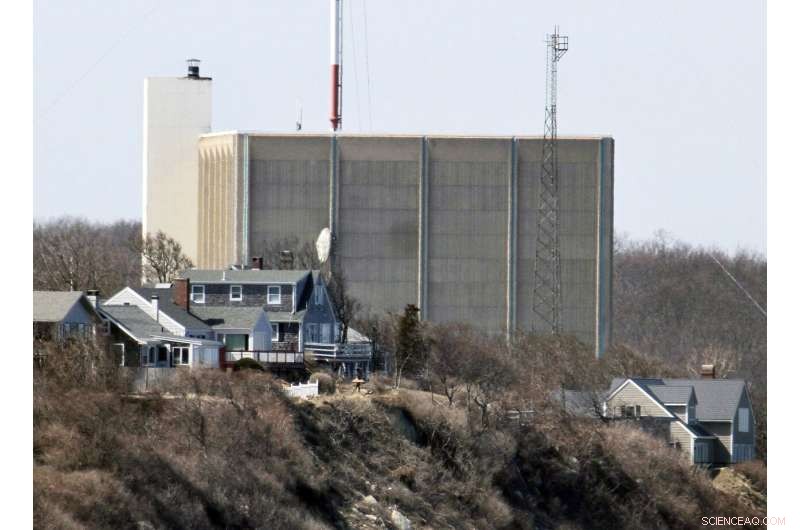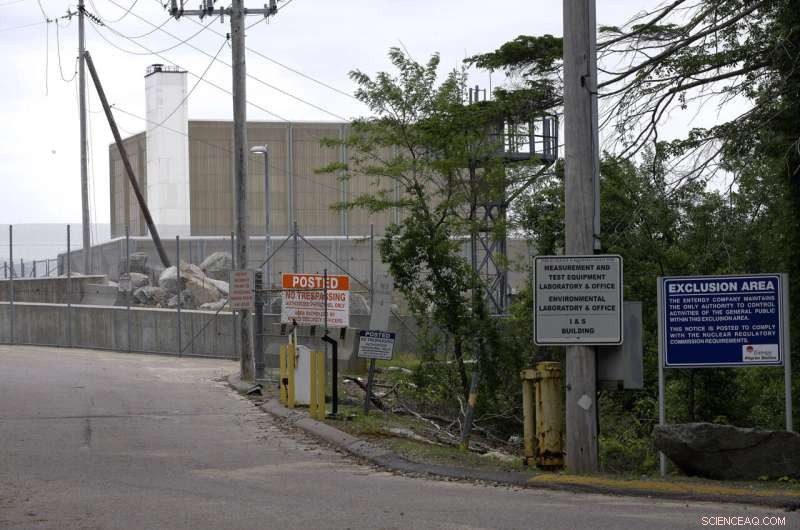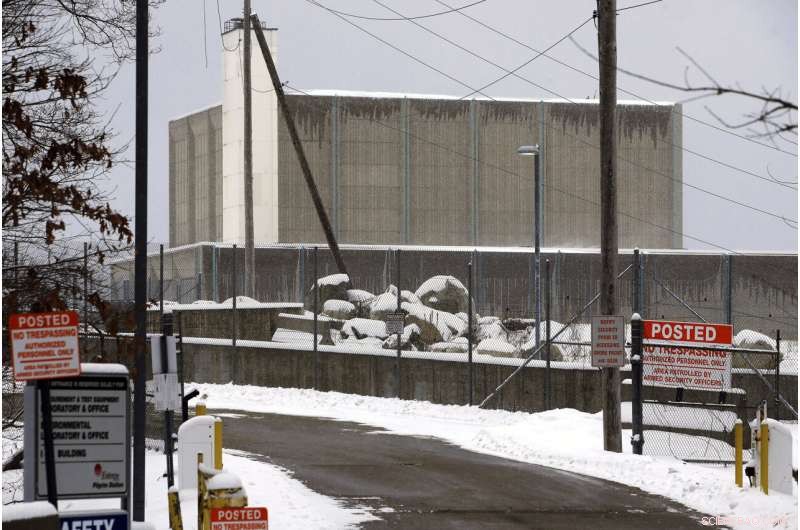
En del av Pilgrim Nuclear Power Station är synlig bortom husen längs kusten av Cape Cod Bay, i Plymouth, Massachusetts, 30 mars 2011. Pilgrim, som stängdes 2019, var en kokvattenreaktor. Vatten cirkulerade konstant genom reaktorkärlet och kärnbränslet och omvandlade det till ånga för att snurra turbinen. Vattnet kyldes och recirkulerades och tog upp radioaktiv förorening. Kredit:AP Photo/Steven Senne, Arkiv
En miljon liter radioaktivt vatten finns i ett före detta kärnkraftverk längs Cape Cod Bay och det måste gå.
Men var, är den irriterande frågan, och kommer staten att ingripa när företaget som avvecklar anläggningen beslutar?
Holtec International överväger att behandla vattnet och släppa ut det i viken, vilket drar hårt motstånd från lokala invånare, skalfiskare och politiker. Holtec överväger också att indunsta det förorenade vattnet eller transportera det till en anläggning i en annan stat.
Kampen i Massachusetts speglar en aktuell, hetsig debatt i Japan om en plan att släppa ut mer än 1 miljon ton renat radioaktivt avloppsvatten i havet från det havererade kärnkraftverket i Fukushima våren 2023. En massiv tsunami 2011 kraschade in i anläggningen. Tre reaktorer smälte ner.
Pilgrim Nuclear Power Station i Plymouth, Massachusetts, stängdes 2019 efter att nästan ett halvt sekel försett regionen med el. USA:s representant William Keating, en demokrat vars distrikt inkluderar Cape, skrev till Holtec med andra högsta lagstiftare i Massachusetts i januari för att motsätta sig att vatten släpps ut i Cape Cod Bay. Han bad U.S. Nuclear Regulatory Commission att granska dess bestämmelser.
Keating sa i slutet av mars att Holtecs hantering av det radioaktiva vattnet kan skapa ett prejudikat eftersom den amerikanska avvecklingsindustrin är i sin linda. De flesta amerikanska kärnkraftverk byggdes mellan 1970 och 1990.
"Om de är lyssnande, lyhörda och arbetar med dessa samhällen är det viktigt", sa han. "Det är budskapet för framtida avvecklingsanläggningar."
Holtec har förvärvat stängda kärnkraftverk över hela landet som en del av sin demonteringsverksamhet, inklusive den tidigare Oyster Creek Generating Station i New Jersey och Indian Point Energy Center i New York. Det övertar ägandet av Palisades kärnkraftverk vid Lake Michigan, som stänger i år.
Pilgrim var en kokvattenreaktor. Vatten cirkulerade konstant genom reaktorkärlet och kärnbränslet och omvandlade det till ånga för att snurra turbinen. Vattnet kyldes och recirkulerades och tog upp radioaktiv förorening.
Cape Cod är ett turistområde. Att ha radioaktivt vatten i bukten, även låga nivåer, är inte bra för marknadsföring, sa den demokratiska delstatsrepresentanten Josh Cutler, som representerar ett distrikt där. Cutler arbetar för att anta lagstiftning för att förbjuda utsläpp av radioaktivt material till kust- eller inlandsvatten.
Holtec sa att Pilgrim redan släppt ut vatten i viken i 50 år medan anläggningen var i drift och miljöstudier, utförda av anläggningsoperatörerna och nu Holtec, har visat liten eller ingen miljöpåverkan. Radiologiska miljörapporter delas med NRC årligen.
"Vi arbetar för att tillhandahålla vetenskaplig data, utbilda allmänheten om verkligheten av strålning i vardagen och arbetar för att experter ska förklara den sanna vetenskapen kontra den känslomässiga rädslan för det okända", skrev talespersonen Patrick O'Brien i ett mejl i mars. .

Warning signs are posted near a gate to the Pilgrim Nuclear Power Station, in Plymouth, Mass., Tuesday, May 28, 2019. Pilgrim, which closed in 2019, was a boiling water reactor. Water constantly circulated through the reactor vessel and nuclear fuel, converting it to steam to spin the turbine. The water was cooled and recirculated, picking up radioactive contamination. Kredit:AP Photo/Steven Senne, Arkiv
WHAT ARE HOLTEC'S OPTIONS?
Holtec could treat the water and discharge it in batches over multiple years, likely the least expensive option. Or, it could evaporate the water on site, as it says it has done with about 680,000 gallons (2,600 kiloliters) over the past two years.
Evaporating the water would be more challenging to do now because the spent nuclear fuel is in storage, and couldn't be used as a heat source. Holtec would have to use a different—likely more expensive—method that would release gas.
Or, Holtec could truck the water to an out-of-state facility, where it could be mixed with clay and buried or placed in an evaporation pond, or released into local waterways. That's what Keating wants.
Vermont Yankee Nuclear Power Station, another boiling water reactor, was shut down in Vernon, Vermont, in 2014. It's sending wastewater to disposal specialists in Texas and other states. Entergy operated and sold both Vermont Yankee and Pilgrim. NorthStar, a separate and competing corporation in the decommissioning business, is dismantling Vermont Yankee.
Nuclear plants occasionally need to dispose of water with low levels of radioactivity when they're operating, so a process to release it in batches into local waterways was developed early in the nuclear industry.
In recent years at Pilgrim, the two largest releases were in 2011, with 29 releases totaling about 325,000 gallons (1,500 kiloliters), and 2013, with 21 releases totaling about 310,000 gallons.
The water from those releases was well below the federal limits for the amount of radionuclides in millirems a person would be exposed to in a year if they ate local seafood or swam in nearby waters, according to the NRC.
NRC spokesperson for the Northeast Neil Sheehan said the limits are set very conservatively and are believed to be protective of the public and environment. He said it's important to consider the role of dilution—once the discharges mix with vast quantities of water any radioactivity is typically not detectable.
WHY ARE PEOPLE WORRIED?
In Duxbury, Kingston and Plymouth Bays, there are 50 oyster farms—the largest concentration in the state, worth $5.1 million last year, according to the Massachusetts Seafood Collaborative. The collaborative said dumping the water would devastate the industry, and the local economy along with it.
Diane Turco, a Harwich resident and longtime Pilgrim watchdog, questions if the water is heavily contaminated, especially from the pool that covered the stored, spent fuel for cooling and shielded workers from radiation.

A no trespassing sign is posted near the entrance to the Pilgrim Nuclear Power Station, at rear, Thursday, Feb. 28, 2019, in Plymouth, Mass. One million gallons of radioactive water is contained inside the former nuclear power plant along Cape Cod Bay. The plant's owner, Holtec International, is considering treating the water and discharging it into the bay. Local residents, shell fishermen and politicians disapprove of the plan. Kredit:AP Photo/Steven Senne, Arkiv
"Isn't this a crazy idea for Holtec to use our bay as their dump? No way," she said.
Others didn't know Pilgrim's water went into the bay in previous years and they don't want it to happen again.
"We can't change that, but we can change what's happening in the future," said Cutler, the state lawmaker. "It's the first time it has ever been decommissioned, so to compare this to the past is a convenient excuse. 'Well, we did it in the past,' that sounds like my kid."
Towns on the Cape are trying to prohibit the dispersal of radioactive materials in their waters. Tribal leaders, fishermen, lobstermen and real estate agents have publicly stated their opposition as well.
Sheehan, the NRC spokesperson, said the water is not different or distinct, compared to water released during the plant's operations. Holtec would have to handle it the same way, by filtering it, putting it into a tank, analyzing the radio isotopes and calculating the environmental impacts if it was released in batches, he added.
WHO GETS THE FINAL SAY?
Holtec wouldn't need a separate approval from the NRC to discharge the water into the bay. However, Holtec would need permission from the U.S. Environmental Protection Agency if the water contained pollutants regulated by the Clean Water Act, such as dissolved metals.
If the water contained only radioactive materials regulated by the NRC, Holtec wouldn't need to ask the EPA for a permit modification, according to the EPA's water division for New England. Holtec has never given the EPA a pollutant characterization of the water associated with decommissioning, the division's director said.
Mary Lampert, of Duxbury, is on a panel created by the state to look at issues related to the Pilgrim's decommissioning. She believes the state could use its existing laws and regulations to stop the dumping and plans to press the Massachusetts attorney general to file a preliminary injunction to do so.
The attorney general's office said it's monitoring the issue and would take any Clean Water Act violations seriously.
Holtec said this week it's examining the water for possible pollutants but the lab results won't be available for awhile.
The company expects to decide what to do with the water later this year. Discharge, evaporation and some limited transportation will likely all be part of the solution, Holtec added.